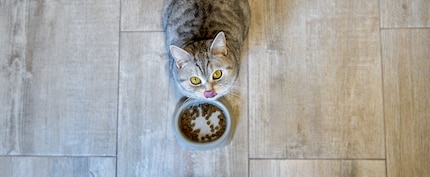

Why does my cat do that? The mystery of purring
Much of what cats do is shrouded in myth. In the series «Why does my cat do that?», I decode some of our feline friends’ mysterious behaviours. This time: purring.
Some sound like the luscious hum of a Rolls Royce, others like the excited whirring of a remote-controlled car. While some felines are barely audible and practically silent. Purring is as individual as each cat themselves.
While Joy, my tricolor, starts her engine loudly the moment you touch her, for little tiger Jasper to start purring, he needs to have a full belly and everything has to be just right – from the atmosphere to the constellations. And even then, I only hear his vibration mode when I put my ear to his head. But why?
The science behind purring
Experts still aren’t entirely sure (site in German) where and how purring happens. But they’ve dispelled the idea that flaps of skin next to the vocal cords or the aorta are responsible. The following theories are possible:
Option 1: the larynx
The most common assumption is that the noise is caused by rhythmic contractions of the laryngeal muscles. This movement widens and narrows the glottis in rapid succession, causing the air to vibrate. This is comparable to the humming of a motor, where regular, rapid movements generate a vibration.
Option 2: the hyoid bone
Other theories relate to the hyoid bone, suggesting it triggers purring by rubbing against the air cats breathe. Almost as if a sheet of paper was fluttering in the air.
Interesting fact: because their muscles aren’t as flexible or controllable, big cats can only purr when they exhale. Domestic cats, on the other hand, are able to do this for longer and also when inhaling. The sound is slightly shorter and louder (27 – 40 Hz) than when exhaling (16 – 28 Hz). The volume is comparable to a whisper. However, some four-legged friends exceed this by a long way:
Every cat purrs differently
Joy’s purring is almost reminiscent of a lawnmower starting up. But why is she so loud while Jasper is barely audible? Apparently this is down to anatomy, the degree of stimulation and age (site in German). Joy is smaller and a year or two older than Jasper (we don’t have exact birth dates). Her muscles and vocal cords may have been better developed. That or she’s just more easily pleased than our perfectionist prince.
Reasons for purring
Now let’s look at the reasons for purring. There are a lot of explanations why cats start this behaviour early on:
- Communication: kittens are born blind and deaf. The mother cat’s purring is vital for them when it comes to finding the teats. By two days old, kittens can already communicate themselves by purring.
- Happiness: cats often start to purr when you stroke them. If their body is relaxed, it means they’re happy.
- Hunger: some cats purr louder when they’re hungry. Researchers have discovered something known as a «solicitation purr». It transforms standard purring into a more urgent, attention-grabbing sound.
- Fear and pain: cats can also calm themselves down by purring when they’re afraid or in pain (more on this in the next section).

Source: Sharomka/Shutterstock
An important vibration
That’s all well and good, but is the feline vibration mode actually useful? Researchers are in agreement that it is. When cats purr, they release the happiness hormone serotonin. This helps them to relax and reduce stress. It can also help healing, for instance if they’ve broken bones, and it has a pain-relieving effect. Cat parents are sometimes confused when their ill pet purrs. So if your cat makes purring noises in new, unusual situations or when their body looks tensed, it’s worth being on the safe side and getting them checked by a vet.
However, purring is usually an extremely positive and soothing sound, even for us humans. It also releases serotonin in people, relieves stress, can even lower blood pressure and has been shown to reduce the risk of heart attacks and heart failure (site in German). So treat your cat to a thorough petting session right away – it’ll do you good, too.

When and how do cats your purr? Let me know in the comments.
I love anything with four legs or roots - especially my shelter cats Jasper and Joy and my collection of succulents. My favourite things to do are stalking around with police dogs and cat coiffeurs on reportages or letting sensitive stories flourish in garden brockis and Japanese gardens.
Practical solutions for everyday problems with technology, household hacks and much more.
Show all

